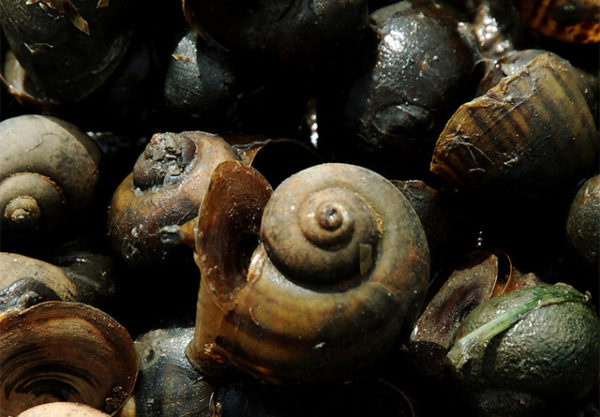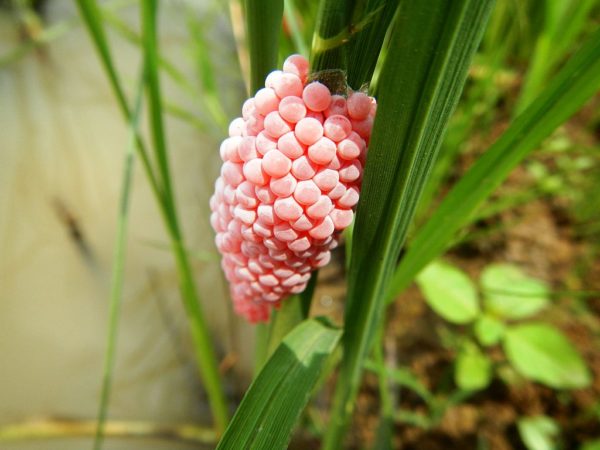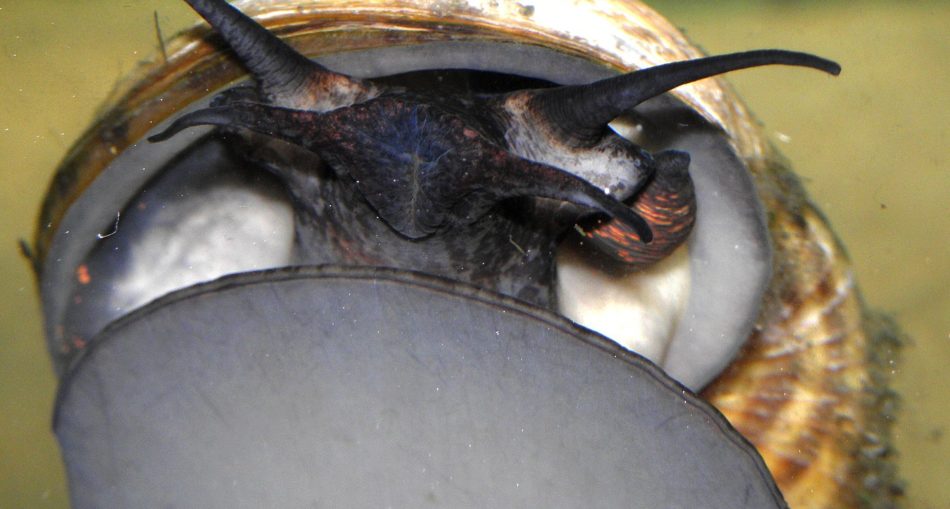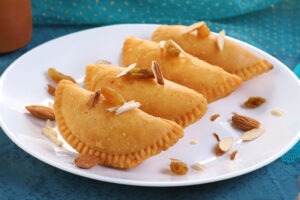
Golden Apple Snails – Image Source: http://www.knowledgebank.irri.org/step-by-step-production/growth/pests-and-diseases/golden-apple-snails
The common snail that is found in Guyana is the Pomacea canaliculata, known locally as ‘Krekete’ or ‘Crekete’. Another popular world-name for this snail is the Golden Apple snail. The ‘krekete’ belongs to the family of Ampullariidae. You can find these aquatic snails in common waterways like drains and trenches. The snail is usually seen clinging to the side of bridges, cunningly hiding between the roots of coconut trees near water and in rice fields. These Golden Apple snails are a common thing to find in the countryside of Guyana. The Golden Apple snails are named after the fruit because some of them grow as large as an apple. They are usually collected by hand or captured in nets from the sides of trenches, lakes, and canals. If you were to look under your bridge or at the edge of a nearby trench, the odds are likely that you will see a pink clutch of snail eggs and the snails would generally be nearby. Finding these snails is an ordeal but can be worth it since these ‘kreketes’ are quite delicious when cooked properly.
Interesting tip:
In Guyana, we remove the shells and curry (bunjal) the fleshy parts of the snail. It goes well with dhal and rice, and it is a very common dish.
Scientific Classification Of The Golden Apple Snail
Golden Apple Snail – Pomacea canaliculata [Scientific Classification]
- Kingdom: Animalia

A clutch of snail eggs – Image Source: https://upload.wikimedia.org/wikipedia/commons/thumb/3/3b/F7951CacarongMatandafvf_13.JPG/1024px-F7951CacarongMatandafvf_13.JPG
- Subkingdom: Bilateria
- Infrakingdom: Protostomia
- Superphylum: Lophozoa
- Phylum: Mollusca
- Class: Gastropoda
- Subclass: Prosobranchia
- Order: Architaenioglossa
- Family: Ampullariidae
- Genus: Pomacea
- Species: Pomacea
Description of The Golden Apple Snail
Golden Apple snails have thick shells in varying shades of brown though they are typically dark brown. The whorls or spirals of the shell are rounded with a deep channel and the height of their spires is low. Because of the features of the shell, the snail is safe to hold. If you were to peer into a snail’s shell, you would see that the lip of the shell doesn’t have a defined colour. Snails have long tentacles and short eye stalks are attached to them. Snails are unable to hear so their eyes are very useful. Their necks are long and can be extended with ease.
Did you know: Snail cannot hear and they depend on their other senses to survive.
The Golden apple snail grows up to 40-60 mm, inclusive of shell size. This type of snail has both lungs and gills. On the right side, there is the gill and on the left, a lung. For movement, the snail uses its muscular foot. Snails secrete mucus which helps them to move their body.
Habitat of The Golden Apple Snail
‘Krekete’ as we know them, thrive in places with a supply of freshwater. They are found in trenches, canals, streams lined with vegetation and in rice fields. They can also live in water with low oxygen levels.
Diet of The Golden Apple Snail
This species of snail feeds on plants in the water or along rivers and streams. They eat succulent and leafy plants, algae, rice seedlings, duckweeds, water hyacinths and sometimes even decomposing organic matter. Soft plants are typically preferred by the Golden Apple snail since it feeds by scraping plant matter with its rough tongue. Golden Apple snails are considered pests in rice fields in Guyana because they eat the young rice seedlings.
Reproduction of The Golden Apple Snail
Adult snails can mate at any time for about 3-4 hours in places with a steady water supply. Their eggs are laid on plants, bridge boards, twigs, and stones or any object close to the water. Snails reproduce quickly, laying as much as six hundred eggs per month. These clutches of eggs are bright pink but turn light pink when it is time to hatch, usually in 7-14 days. The hatchlings grow quickly and have an almost insatiable appetite.
Predators of The Golden Apple Snail
The Golden Apple snail is a tasty morsel to ducks who eat the young snails and flesh of older ones. Field rats would use their teeth to bite the shells of the snails and devour the soft bodies. Sometimes, red ants have access to the eggs and feed on them since they are not submerged in water. Birds also find snails as a source of food. When cooked properly, humans also eat the flesh of the snails.
Interesting Snail Facts:
- There are three types of snails, land, sea, and freshwater.
- Snails are able to repair damages to their shells over time.
- They are nocturnal creatures.
- Snails can be found everywhere on Earth.
- A snail will not get cut if it moves over a sharp razor blade because of its protective slimy mucus.
- Some snails have hairy shells.
- Snails are rich in protein.
Though these ‘Krekete’ or Golden Apple snails are viewed somewhat as a pest, they can be used as food. In Guyana, many persons living in the countryside would pick out these snails during fishing trips. The Golden Apple snail is only one of the hundreds of species in the world.
Article References
- https://grdb.gy/wp-content/uploads/2016/09/Snail-Management.pdf
- https://www.itis.gov/servlet/SingleRpt/SingleRpt?search_topic=TSN&search_value=568121#null
- https://www.kaieteurnewsonline.com/2009/02/15/the-snail-2/
- https://www.cabi.org/isc/datasheet/68490
- https://www.japantimes.co.jp/life/2008/10/22/environment/golden-apple-snail/#.Xh8eQMhKjIU
- https://www.applesnail.net/pestalert/management_guide/pest_management.php#feeding
- https://kids.lovetoknow.com/snail-facts-kids
- Main Image: By CHUCAO – Own work, CC BY-SA 3.0, https://commons.wikimedia.org/w/index.php?curid=29286813







